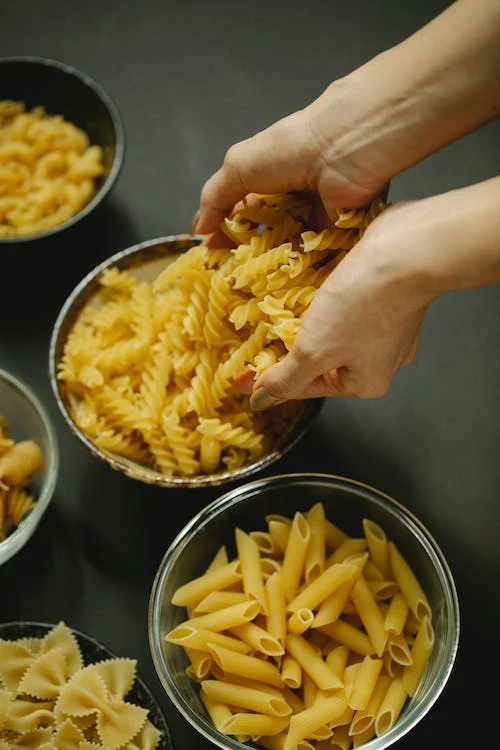To produce pasta, a dough made of wheat flour, water, and/or eggs is frequently used. The dough is then molded into sheets or various shapes and baked by boiling or baking. Pasta is broadly categorized into two groups: dried and fresh. Although it can be created at home, the majority of dry pasta is produced commercially using an extrusion method.
Fresh pasta is traditionally produced by hand, occasionally with the use of tiny technology. Large-scale machinery is used in the commercial production of fresh pasta that is sold in grocery shops. Pasta comes in many different forms and variants, with 310 distinct varieties having more than 1,300 recorded names.
What is protein pasta
Pasta is one of the most beloved foods. It is a hearty food that is satisfying and everyone craves it from time to time, whether it be in the form of a cozy lasagna meal, a classic aglio e olio or spaghetti and meatballs dish. I mean, who doesn’t love pasta, right?
But for people who are concerned about their health may not enjoy eating high-carb pasta especially those who are in a strict diet, but there is an alternative for individuals who do not enjoy regular pasta. The best choice for you is protein pasta.
Did you know that protein pasta has additional nutritional advantages in addition to having a greater protein content per serving? High protein pasta provides more fiber, fewer carbs, and minerals per serving than wheat pasta does.
For vegetarians and other plant-based eaters who want to expand their selection of protein sources, it’s an exceptionally excellent choice. Many of these high-protein pasta options also make excellent low-carb pasta choices.
The USDA’s Dietary Guidelines for Americans recommend that most adults get at least 46 grams of protein per day, and several high-protein pastas have an average protein content of 20 grams. Pasta producers have increased the protein content of their product without changing their recognizable form or delicious flavor by adding ingredients that are natural sources of protein such as lentils, chickpeas, and even eggs.
These pastas have a considerable quantity of fiber per serving, which is beneficial for digestion, balancing blood sugar, and a variety of other processes. For vegans and others on high-protein diets, protein pasta is a particularly good option. Additionally, as many of these varieties of pasta are manufactured with beans, they are inherently gluten-free, expanding the range of food alternatives available to people following a gluten-free diet.
Selecting a High-Protein Pasta
With a little knowledge, choosing the best high-protein pasta is rather straightforward. To find out how much protein is in one serving of pasta, check the nutrition label first. Always keep in mind that when you are grocery shopping always check the label of each product you are purchasing.
There isn’t a set standard for what constitutes “high-protein” pasta, but generally speaking, you should go for a kind that contains more protein per serving than 7 grams, or more than what regular wheat-based pasta offers.
Protein Pasta for weight loss
You should be aware that these pastas still have the same number of calories as conventional pasta even if they are produced from veggies rather than wheat. The important thing is that the protein and fiber content will make you feel satisfied for hours after eating.
Because protein pastas make you feel fuller after eating them, you might be able to consume less servings of them. Additionally, cold pasta salads can be made with high-protein pasta. However, because some versions of these noodles don’t include gluten, they might not maintain their shape when immersed in water for a prolonged amount of time.
Protein Pasta’s dietary composition
- Protein pasta is frequently supplemented with necessary vitamins and minerals, including iron, folate, and B vitamins.
- Protein pasta is a good source of dietary fiber, which helps with digestion, encourages fullness, and supports the maintenance of a healthy weight.
- High in Protein: Compared to ordinary pasta, protein pasta has a much higher protein content per serving, averaging 20–25 grams.
- Low in Carbohydrates: Protein pasta is a good choice for people on a low-carb or ketogenic diet because it contains fewer carbohydrates than conventional pasta.
Benefits of Protein Pasta
- Increases energy– An essential macronutrient that gives energy is protein. You can increase your energy and feel energized all day long by include protein pasta in your meals.
- Promotes the Growth and Repair of Muscles- In order to build and repair muscles, you need protein. You can give your body the essential amino acids it needs to maintain muscle health by eating protein pasta.
- Aids in blood sugar regulation- Protein pasta is a good choice for people with diabetes or those trying to control their blood sugar levels because of the decreased carbohydrate content, which can help regulate blood sugar levels.
- Helps with weight management- Protein pasta’s high protein and fiber content can make you feel filled for longer, lowering your risk of overeating and supporting weight management.
The best way to include protein pasta in your diet
Protein pasta may be used in a variety of meals and is highly versatile. If you want to add protein to your diet, you can use protein pasta in place of standard pasta in your favorite pasta dishes. You can substitute protein pasta in stir-fries or other noodle-based foods if you prefer to eat noodles.
Additionally, you may make a protein-rich pasta bake with your preferred components or a protein-rich pasta salad with fresh vegetables and a mild vinaigrette. It is really up to you on how would you incorporate protein pasta in your daily diet.
Conclusion
If you want to increase your protein intake and are health aware, protein pasta is an excellent alternative to standard pasta. You can look up many recipes that pair nicely with protein pasta. Explore different recipes in different cuisines so that you can discover different flavors that will indulge your taste.

